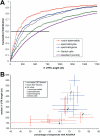Systematic variation in mRNA 3'-processing signals during mouse spermatogenesis
- PMID: 17158511
- PMCID: PMC1802579
- DOI: 10.1093/nar/gkl919
Systematic variation in mRNA 3'-processing signals during mouse spermatogenesis
Abstract
Gene expression and processing during mouse male germ cell maturation (spermatogenesis) is highly specialized. Previous reports have suggested that there is a high incidence of alternative 3'-processing in male germ cell mRNAs, including reduced usage of the canonical polyadenylation signal, AAUAAA. We used EST libraries generated from mouse testicular cells to identify 3'-processing sites used at various stages of spermatogenesis (spermatogonia, spermatocytes and round spermatids) and testicular somatic Sertoli cells. We assessed differences in 3'-processing characteristics in the testicular samples, compared to control sets of widely used 3'-processing sites. Using a new method for comparison of degenerate regulatory elements between sequence samples, we identified significant changes in the use of putative 3'-processing regulatory sequence elements in all spermatogenic cell types. In addition, we observed a trend towards truncated 3'-untranslated regions (3'-UTRs), with the most significant differences apparent in round spermatids. In contrast, Sertoli cells displayed a much smaller trend towards 3'-UTR truncation and no significant difference in 3'-processing regulatory sequences. Finally, we identified a number of genes encoding mRNAs that were specifically subject to alternative 3'-processing during meiosis and postmeiotic development. Our results highlight developmental differences in polyadenylation site choice and in the elements that likely control them during spermatogenesis.
Figures




Similar articles
-
Pre-messenger RNA cleavage factor I (CFIm): potential role in alternative polyadenylation during spermatogenesis.Biol Reprod. 2008 Mar;78(3):472-82. doi: 10.1095/biolreprod.107.064774. Epub 2007 Nov 21. Biol Reprod. 2008. PMID: 18032416
-
[Regulation of spermatogenesis by polyadenylation and deadenylation of mRNAs].Tanpakushitsu Kakusan Koso. 2009 Dec;54(16 Suppl):2073-9. Tanpakushitsu Kakusan Koso. 2009. PMID: 21089620 Review. Japanese. No abstract available.
-
Alternative cleavage and polyadenylation in spermatogenesis connects chromatin regulation with post-transcriptional control.BMC Biol. 2016 Jan 22;14:6. doi: 10.1186/s12915-016-0229-6. BMC Biol. 2016. PMID: 26801249 Free PMC article.
-
Patterns of variant polyadenylation signal usage in human genes.Genome Res. 2000 Jul;10(7):1001-10. doi: 10.1101/gr.10.7.1001. Genome Res. 2000. PMID: 10899149 Free PMC article.
-
Reexamining the polyadenylation signal: were we wrong about AAUAAA?Mol Cell Endocrinol. 2002 Apr 25;190(1-2):1-8. doi: 10.1016/s0303-7207(02)00044-8. Mol Cell Endocrinol. 2002. PMID: 11997173 Review.
Cited by
-
The τCstF-64 polyadenylation protein controls genome expression in testis.PLoS One. 2012;7(10):e48373. doi: 10.1371/journal.pone.0048373. Epub 2012 Oct 26. PLoS One. 2012. PMID: 23110235 Free PMC article.
-
Chromatoid Body Protein TDRD6 Supports Long 3' UTR Triggered Nonsense Mediated mRNA Decay.PLoS Genet. 2016 May 5;12(5):e1005857. doi: 10.1371/journal.pgen.1005857. eCollection 2016 May. PLoS Genet. 2016. PMID: 27149095 Free PMC article.
-
Genetics and regulatory impact of alternative polyadenylation in human B-lymphoblastoid cells.PLoS Genet. 2012;8(8):e1002882. doi: 10.1371/journal.pgen.1002882. Epub 2012 Aug 16. PLoS Genet. 2012. PMID: 22916029 Free PMC article.
-
Alternative polyadenylation in the nervous system: to what lengths will 3' UTR extensions take us?Bioessays. 2014 Aug;36(8):766-77. doi: 10.1002/bies.201300174. Epub 2014 Jun 5. Bioessays. 2014. PMID: 24903459 Free PMC article. Review.
-
RNA decay, evolution, and the testis.RNA Biol. 2017 Feb;14(2):146-155. doi: 10.1080/15476286.2016.1265199. Epub 2016 Dec 2. RNA Biol. 2017. PMID: 27911186 Free PMC article. Review.
References
-
- Edmonds M. A history of poly a sequences: from formation to factors to function. Prog. Nucleic Acid Res. Mol. Biol. 2002;71:285–389. - PubMed
-
- Keller W., Minvielle-Sebastia L. A comparison of mammalian and yeast pre-mRNA 3′-end processing. Curr. Opin. Cell. Biol. 1997;9:329–336. - PubMed
-
- Colgan D.F., Manley J.L. Mechanism and regulation of mRNA polyadenylation. Genes Dev. 1997;11:2755–2766. - PubMed
Publication types
MeSH terms
Substances
Grants and funding
LinkOut - more resources
Full Text Sources
Research Materials

